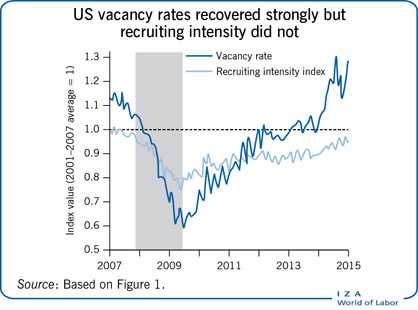Elevator pitch
When hiring new workers, employers use a wide variety of different recruiting methods in addition to posting a vacancy announcement, such as adjusting education, experience, or technical requirements, or offering higher wages. The intensity with which employers make use of these alternative methods can vary widely depending on a firm’s performance and with the business cycle. In fact, persistently low recruiting intensity partly helps to explain the sluggish pace of job growth in the US economy following the Great Recession, and the historically subpar wage growth during the subsequent expansion.

Key findings
Pros
An employer’s recruiting intensity is an important part of hiring and job creation.
Changes in recruiting intensity can account for some structural or “mismatch” unemployment.
Businesses that are fast-growing recruit more intensely.
Positions that offer higher wages tend to have greater recruiting effort and generate more interviewees per job offer.
Cons
Until recently, theories of the labor market generally ignored recruiting intensity, complicating policy analysis.
Recruiting intensity is difficult to measure and is not well understood by economists.
Little is known about which recruiting methods matter most, or which aspects of recruiting intensity might be most responsive to policy.
Existing evidence is unable to identify supply- or demand-driven changes in recruiting intensity.